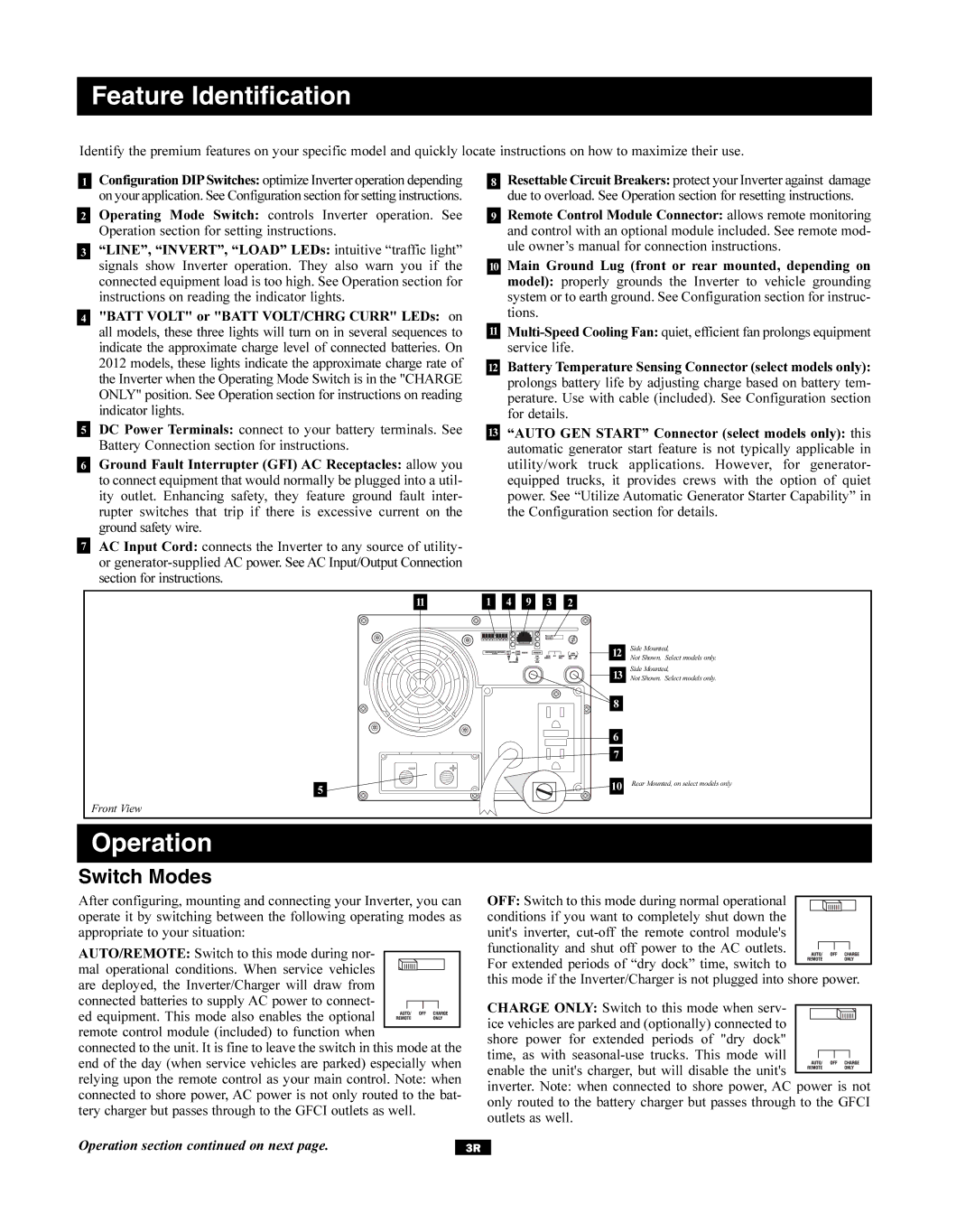
Feature Identification
Identify the premium features on your specific model and quickly locate instructions on how to maximize their use.
1Configuration DIPSwitches: optimize Inverter operation depending on your application. See Configuration section for setting instructions.
2Operating Mode Switch: controls Inverter operation. See Operation section for setting instructions.
3“LINE”, “INVERT”, “LOAD” LEDs: intuitive “traffic light” signals show Inverter operation. They also warn you if the connected equipment load is too high. See Operation section for instructions on reading the indicator lights.
4"BATT VOLT" or "BATT VOLT/CHRG CURR" LEDs: on all models, these three lights will turn on in several sequences to indicate the approximate charge level of connected batteries. On 2012 models, these lights indicate the approximate charge rate of the Inverter when the Operating Mode Switch is in the "CHARGE ONLY" position. See Operation section for instructions on reading indicator lights.
5DC Power Terminals: connect to your battery terminals. See Battery Connection section for instructions.
6Ground Fault Interrupter (GFI) AC Receptacles: allow you to connect equipment that would normally be plugged into a util- ity outlet. Enhancing safety, they feature ground fault inter- rupter switches that trip if there is excessive current on the ground safety wire.
7AC Input Cord: connects the Inverter to any source of utility- or
8Resettable Circuit Breakers: protect your Inverter against damage due to overload. See Operation section for resetting instructions.
9Remote Control Module Connector: allows remote monitoring and control with an optional module included. See remote mod- ule owner’s manual for connection instructions.
10Main Ground Lug (front or rear mounted, depending on model): properly grounds the Inverter to vehicle grounding system or to earth ground. See Configuration section for instruc- tions.
11
12Battery Temperature Sensing Connector (select models only): prolongs battery life by adjusting charge based on battery tem- perature. Use with cable (included). See Configuration section for details.
13“AUTO GEN START” Connector (select models only): this automatic generator start feature is not typically applicable in utility/work truck applications. However, for generator- equipped trucks, it provides crews with the option of quiet power. See “Utilize Automatic Generator Starter Capability” in the Configuration section for details.
11 | 1 | 4 | 9 | 3 | 2 |
5 ![]()
Front View
12 | Side Mounted, |
Not Shown. Select models only. | |
13 | Side Mounted, |
Not Shown. Select models only. | |
8 |
|
6 |
|
7 |
|
10 | Rear Mounted, on select models only |
Operation
Switch Modes
After configuring, mounting and connecting your Inverter, you can operate it by switching between the following operating modes as appropriate to your situation:
AUTO/REMOTE: Switch to this mode during nor-
mal operational conditions. When service vehicles ![]()
![]() are deployed, the Inverter/Charger will draw from connected batteries to supply AC power to connect-
are deployed, the Inverter/Charger will draw from connected batteries to supply AC power to connect- ![]()
![]()
![]() ed equipment. This mode also enables the optional
ed equipment. This mode also enables the optional ![]()
![]()
![]()
![]()
![]()
![]()
![]()
![]()
![]()
![]()
![]() remote control module (included) to function when
remote control module (included) to function when
connected to the unit. It is fine to leave the switch in this mode at the end of the day (when service vehicles are parked) especially when relying upon the remote control as your main control. Note: when connected to shore power, AC power is not only routed to the bat- tery charger but passes through to the GFCI outlets as well.
Operation section continued on next page. | 3R |
OFF: Switch to this mode during normal operational ![]() conditions if you want to completely shut down the
conditions if you want to completely shut down the
unit's inverter, ![]()
![]()
![]() For extended periods of “dry dock” time, switch to
For extended periods of “dry dock” time, switch to ![]()
this mode if the Inverter/Charger is not plugged into shore power.
CHARGE ONLY: Switch to this mode when serv- ![]() ice vehicles are parked and (optionally) connected to
ice vehicles are parked and (optionally) connected to
shore power for extended periods of "dry dock" time, as with ![]()
inverter. Note: when connected to shore power, AC power is not only routed to the battery charger but passes through to the GFCI outlets as well.
